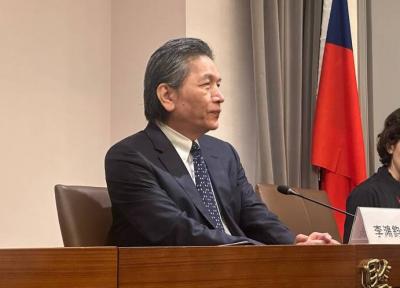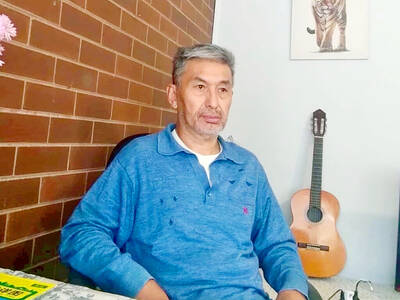Changes in daily COVID-19 caseloads over the next couple of weeks would affect the timing of the border being reopened, the Central Epidemic Command Center (CECC) said yesterday as it reported 46,673 new local and 229 imported cases, as well as 39 deaths.
The CECC had previously predicted that a wave of infections fueled by the Omicron BA.5 subvariant of SARS-CoV-2 would peak yesterday.
Yesterday’s caseload was 6 percent lower than Wednesday last week and the decline was evident across the nation, said Centers for Disease Control (CDC) Director-General Chou Jih-haw (周志浩), head of the CECC’s disease surveillance division.
Deputy Minister of Health and Welfare Victor Wang (王必勝), who heads the CECC, said the caseloads reported yesterday and on Tuesday were lower from their respective week-earlier data.
It is likely that the latest COVID-19 wave peaked on Wednesday last week, but the center would observe the trend for a few more days to be on the safe side, Wang said.
Asked whether border controls and quarantine for arrivals could be lifted earlier than planned as daily caseloads have been falling, Wang said: “We have said that border reopening would happen after the BA.5 surge peaks and cases start to decline.”
“Judging from the current situation, it is possible that the timing of reopening can be moved forward,” he said.
The CECC has drafted plans to reopen the border and they are being discussed by government agencies, which need to assess their feasibility and the time they need to prepare, Wang said.
The CECC would announce the policies before implementing them, he said.
The next one to two weeks is a key observation period for the center to determine when reopening plans can be implemented, he said, adding that they are expected to take effect next month.
Separately, Wang said that government-funded weekly COVID-19 tests at long-term care facilities would be extended until Oct. 31, as testing positivity rates have remained relatively low since the policy took effect.
Under the policy, facility residents are tested twice a week, while workers are tested once a week.
In related news, a batch of the Novavax COVID-19 vaccine comprising 504,000 doses would arrive in Taiwan today, Wang said.
The doses would be offered to people aged 12 or older as their primary series or booster shots, he said, adding that the doses would be dispatched to local governments on Friday next week.
CDC Deputy Director-General Philip Lo (羅一鈞), deputy head of the CECC’s medical response division, said that among the 39 deaths confirmed yesterday, the youngest was a three-year-old boy who developed symptoms and tested positive on Friday last week.
The boy was rushed to a hospital after his parents found him unresponsive the next day, Lo said.
He died due to respiratory failure, upper respiratory infection and COVID-19, Lo said.
Six cases of multisystem inflammatory syndrome in children (MIS-C) were also confirmed yesterday, including a 10-year-old boy and five other children aged one to five, Lo added.
One of them is a four-year-old girl who was diagnosed with COVID-19 on May 28, he said.
She developed a fever and diarrhea on Sept. 6 and was taken to an emergency room on Sept. 9, where she was diagnosed with conjunctivitis, strawberry tongue (a swollen and bumpy tongue), and dried and cracked lips, and diagnosed with MIS-C, he said.
The onset of MIS-C symptoms occurred 101 days after the girl was diagnosed with COVID-19, which is the longest such interval reported so far, he added.
A five-year-old boy was confirmed to have serious MIS-C, Lo said.
He tested positive on July 20 and developed a fever, conjunctivitis, rashes and abdominal pain on Aug. 29, Lo said, adding that the boy was hospitalized for suspected MIS-C on Sept. 5.
The boy was later admitted to an intensive care unit after he was found to have an enlarged coronary artery, weakened heart contractions, low heart pressure and cardiogenic shock, Lo said, adding that the boy recovered after treatment and was discharged from hospital on Saturday.

Taipei has once again made it to the top 100 in Oxford Economics’ Global Cities Index 2025 report, moving up five places from last year to 60. The annual index, which was published last month, evaluated 1,000 of the most populated metropolises based on five indices — economics, human capital, quality of life, environment and governance. New York maintained its top spot this year, placing first in the economics index thanks to the strength of its vibrant financial industry and economic stability. Taipei ranked 263rd in economics, 44th in human capital, 15th in quality of life, 284th for environment and 75th in governance,

The Sports Administration yesterday demanded an apology from the national table tennis association for barring 17-year-old Yeh Yi-tian (葉伊恬) from competing in the upcoming World Table Tennis (WTT) United States Smash tournament in Las Vegas this July. The sports agency said in a statement that the Chinese Taipei Table Tennis Association (CTTTA) must explain to the public why it withdrew Yeh from the WTT tournament in Las Vegas. The sports agency said it contacted the association to express its disapproval of the decision-making process after receiving a complaint from Yeh’s coach, Chuang

Control Yuan Secretary-General Lee Chun-yi (李俊俋) tendered his resignation last night, admitting that he had misused a government vehicle, as reported by media. His resignation was immediately accepted by the Control Yuan. In a statement explaining why he had resigned, Lee apologized for using a Control Yuan vehicle to transport his dog to a pet grooming salon on May 20. The issue first came to light late last month, when TVBS News reported that Lee had instructed his driver to take the dog to the salon. The news channel broadcast photos that it said were taken by an unnamed whistle-blower, which purportedly showed the

A former officer in China’s People’s Liberation Army (PLA) who witnessed the aftermath of the 1989 Tiananmen Square massacre has warned that Taiwan could face a similar fate if China attempts to unify the country by force. Li Xiaoming (李曉明), who was deployed to Beijing as a junior officer during the crackdown, said Taiwanese people should study the massacre carefully, because it offers a glimpse of what Beijing is willing to do to suppress dissent. “What happened in Tiananmen Square could happen in Taiwan too,” Li told CNA in a May 22 interview, ahead of the massacre’s 36th anniversary. “If Taiwanese students or